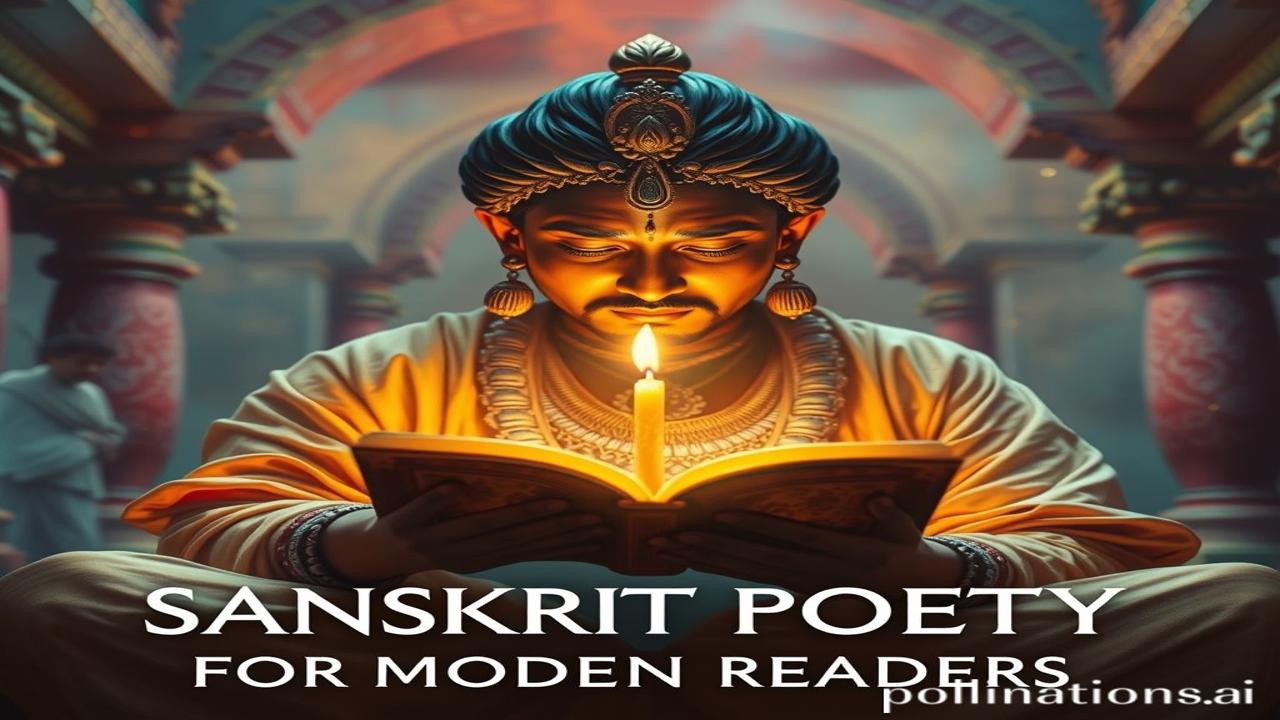Sanskrit Poetry for Modern Readers: खोई हुई आवाज़ों की तलाश
Kabhi socha hai, hawa mein ghuli hui woh prachin dhwani, jo humare ragon mein sadiyon se daud rahi hai, kya kehti hai? Imagine walking through a bustling marketplace in ancient India, the air thick with the scent of sandalwood and spices, the rhythmic chanting of shlokas echoing from a nearby temple. That’s the world of Sanskrit poetry – a world waiting to be rediscovered. Waqt ki dhool mein kuch kahaniyan chhup jaati hain, lekin Sanskrit kavita ek aisi khoj hai jo hamari आत्मा se seedhe judti hai. Let’s unearth these treasures together, shall we?
इतिहासिक पृष्ठभूमि: Sanskrit Kavita – Ek Dharohar
Sanskrit poetry, or kavya, isn’t just verses rhyming in a dead language. It’s a vibrant tapestry woven with threads of philosophy, mythology, love, and the very essence of existence. Originating in ancient India, possibly as early as 1500 BCE with the Vedic hymns, it flourished for centuries, influencing every aspect of Indian culture, from religion and philosophy to art and drama.
The Ramayana and Mahabharata, epic poems composed in Sanskrit, are perhaps the most well-known examples. But Sanskrit poetry encompasses so much more! Think of the delicate beauty of Kalidasa’s Meghaduta, the philosophical depth of the Bhagavad Gita, or the intricate wordplay of Bhartrihari’s Shringara Shataka. This wasn’t just writing; it was yoga for the mind, a way to connect with the divine, and a reflection of the human condition.
Why is it important? Because it’s a direct link to our past, a window into the minds and hearts of our ancestors. It shows us how they understood the world, how they loved, how they struggled. And in understanding them, we understand ourselves a little better.
ज़मीनी सच – लोग और जीवन: Kavi Aur Unki Kahaniyan
Imagine a young Kalidasa, a simpleton initially, blessed by Goddess Kali. He transforms into a literary genius, his words painting vivid pictures of nature and human emotions. Ya phir, visualize a bustling court, with poets vying for the king’s patronage, their verses echoing through the halls.
Or consider the life of a village artisan, finding solace and inspiration in the beauty of nature, composing simple yet profound verses during his work. Ma Rukmini ne aaj naye kapde pehne, kyunki mandir mein utsav tha aur kavi, apne haathon mein kalam liye, apne kavya se deviyon ka gunगान kar raha tha.
These poets weren’t detached intellectuals; they were deeply connected to the pulse of life. Their poetry reflected the joys and sorrows of everyday people, the triumphs and tragedies of kings and kingdoms. They wrote about love, loss, war, peace, duty, and devotion – themes that still resonate with us today.
धरोहर और पहचान: Sanskrit Kavita Aaj Kal
Do we see echoes of Sanskrit poetry today? Absolutely! Its influence permeates almost every aspect of Indian culture. From the bhajans sung in temples to the Bollywood songs we hum along to, from the philosophical underpinnings of Yoga and Ayurveda to the intricate designs of our temples, Sanskrit kavita’s roots are everywhere.
Think of the Sanskrit shlokas chanted during wedding ceremonies, the names of our deities, the very language we use – so many words are derived from Sanskrit. It’s an integral part of Bharatiyata (Indianness), a testament to the enduring power of our heritage. By connecting with Sanskrit poetry, we are connecting with our own identity, our own roots.
मजेदार तथ्य या भ्रम-भंजक: Shocking Truths about Sanskrit
Log samajhte hain ki Sanskrit ek ‘dead’ language hai, lekin asli sach yeh hai ki aaj bhi kuch gaon mein Sanskrit बोली जाती है! It’s not just a language of the past; it’s a living, breathing tradition. Aur ek aur baat! Sanskrit poetry isn’t all serious philosophy. There are plenty of witty and humorous verses too! Think of rib-tickling satires and playful riddles.
दृश्य और भावनाएं: Painting Pictures with Words
Close your eyes. Imagine the scent of jasmine and incense filling the air. Feel the cool touch of marble under your feet in a temple courtyard. Hear the rhythmic chanting of mantras, the melodic strains of a veena, the rustling of leaves in a sacred grove.
What did the air smell like? Sugandhit, with hints of sandalwood and jasmine. How did the temple walls feel? Cold and smooth, etched with intricate carvings. What sounds echoed in the streets? The hustle and bustle of the marketplace, the calls of vendors, the laughter of children, and the ever-present hum of Sanskrit mantras.
अंतिम विचार या उद्धरण: Unlocking the Secrets of the Soul
Sanskrit poetry is more than just words on a page; it’s a gateway to a deeper understanding of ourselves and the world around us. It’s a reminder that even in this fast-paced, modern world, there’s still room for beauty, wisdom, and connection.
Let’s end with a beautiful Sanskrit shloka:
“Vasudhaiva Kutumbakam” – The world is one family.
This simple yet profound idea, expressed in Sanskrit centuries ago, is more relevant now than ever before. Let the echoes of Sanskrit poetry guide us towards a more compassionate and understanding world. Aur yaad rakhiyega, har ek shlok, ek nayi kahani lekar aata hai… just waiting to be heard.
